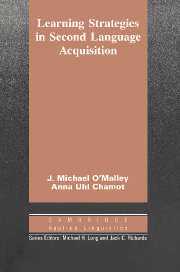Book contents
- Frontmatter
- Contents
- Series editors' preface
- Preface
- 1 Introduction
- 2 A cognitive theory of learning
- 3 How cognitive theory applies to second language acquisition
- 4 Learning strategies: methods and research
- 5 Strategies used by second language learners
- 6 Instruction in learning strategies
- 7 Learning strategies: models and materials
- 8 Summary and conclusions
- Glossary
- References
- Author index
- Subject index
8 - Summary and conclusions
Published online by Cambridge University Press: 05 October 2012
- Frontmatter
- Contents
- Series editors' preface
- Preface
- 1 Introduction
- 2 A cognitive theory of learning
- 3 How cognitive theory applies to second language acquisition
- 4 Learning strategies: methods and research
- 5 Strategies used by second language learners
- 6 Instruction in learning strategies
- 7 Learning strategies: models and materials
- 8 Summary and conclusions
- Glossary
- References
- Author index
- Subject index
Summary
Our primary intent has been to establish a foundation for the application of learning strategies to theory, research, and practice in second language acquisition. We began by describing the state of knowledge on these issues at the beginning of our research. We then presented a rationale and approach in cognitive theory for discussing learning strategies in second language acquisition. In the process, we indicated the types of constructs in second language acquisition to which the cognitive theory can be applied and described contributions the theory makes to understanding second language phenomena. We then discussed specific studies of learning strategies in second language acquisition, including studies intended for strategy definition and classification, strategy description with different types of learners and tasks, and validation of strategy effectiveness, which included correlational studies and strategy training research. Finally, we presented some instructional models that draw specifically upon this work in learning strategies and discussed one model in particular that has applications for second language classrooms.
This chapter summarizes what is known in theory, research, and practice beyond what was known at the beginning of our work. We also indicate what is not known and what some of the limitations are of the work reviewed. Finally, we provide some direction for future theory development, research, and instructional modeling.
Theoretical developments
Where cognitive theory has succeeded is in drawing a picture of how information is stored in memory and what processes are entailed in learning.
- Type
- Chapter
- Information
- Learning Strategies in Second Language Acquisition , pp. 214 - 228Publisher: Cambridge University PressPrint publication year: 1990



